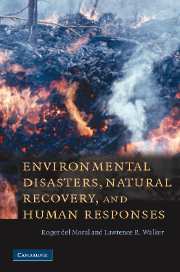Book contents
- Frontmatter
- Contents
- Preface and acknowledgements
- 1 Introduction: a crescendo of destruction
- 2 Natural disturbances: synergistic interactions with humans
- 3 Infertile and unstable habitats
- 4 Infertile and stable habitats
- 5 Fertile and unstable habitats
- 6 Fertile and stable habitats
- 7 The lessons learned
- Glossary
- Illustration credits
- Index
- Plate section
- References
5 - Fertile and unstable habitats
Published online by Cambridge University Press: 11 September 2009
- Frontmatter
- Contents
- Preface and acknowledgements
- 1 Introduction: a crescendo of destruction
- 2 Natural disturbances: synergistic interactions with humans
- 3 Infertile and unstable habitats
- 4 Infertile and stable habitats
- 5 Fertile and unstable habitats
- 6 Fertile and stable habitats
- 7 The lessons learned
- Glossary
- Illustration credits
- Index
- Plate section
- References
Summary
INTRODUCTION
Not all disturbances cause a loss of fertility. Disturbances typically include events that cause a loss of biomass (plant and animal tissues, or merely some organic matter). However, disturbances can also involve the displacement of biomass across the landscape. When biomass floats downstream, the areas where that biomass is deposited can become more fertile than they were before the disturbance. Ocean currents, tides and storm surges, and the seasonal turnover of lake waters also redistribute biomass and nutrients. Many civilizations have depended on such redistribution of nutrients. River floodplains have supported mighty cultures in Egypt along the Nile and in western Asia along the Tigris and Euphrates and still periodically fertilize many agricultural hotspots with organic and mineral-rich sediments. Coastal cultures have long depended on the bountiful products of cold, upwelling ocean currents that bring nutrient-rich waters to coastlines such as Peru and Norway.
This chapter explores how humans interact with fertile, unstable habitats after sudden or chronic disasters. These habitats include unstable slopes that result in landslides, river floodplains, lakeshores and estuaries. Landslides may be hard to farm and build on, but the burgeoning human population and increasingly sophisticated building technology have led to intensive human activities, both urban and agricultural, in these habitats. It is appreciated that living on a floodplain carries dangers, but floodplains are among the most fertile agricultural sites. Thus, while humans would prefer to live on stable sites that do not flood, they often rely on floods to deposit nutrients on their fields.
- Type
- Chapter
- Information
- Environmental Disasters, Natural Recovery and Human Responses , pp. 100 - 143Publisher: Cambridge University PressPrint publication year: 2007



